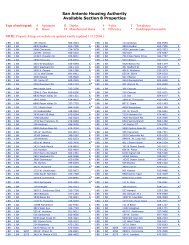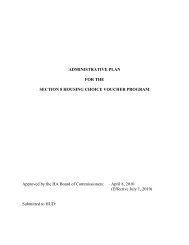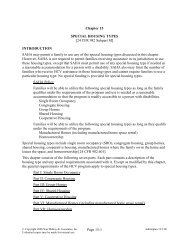AGENDA - San Antonio Housing Authority
AGENDA - San Antonio Housing Authority
AGENDA - San Antonio Housing Authority
- No tags were found...
Create successful ePaper yourself
Turn your PDF publications into a flip-book with our unique Google optimized e-Paper software.
IntroductionThe 2013 Demographic Report provides summaryinformation and maps describing households thatreceive assistance from public housing and assistedhousing programs. This report is designed to beupdated annually in order to identify demographictrends over time. The 2013 Demographic Report,being the first of the series, establishes baselinesagainst which future trends can be compared.Over 19,000 households receive housing assistancefrom the <strong>San</strong> <strong>Antonio</strong> <strong>Housing</strong> <strong>Authority</strong> throughPublic <strong>Housing</strong> (PH) and assisted housing programs;including <strong>Housing</strong> Choice Voucher (HCV) programand other local voucher programs. For the purposesof this report, all voucher programs have beengrouped together. The <strong>San</strong> <strong>Antonio</strong> <strong>Housing</strong><strong>Authority</strong> (SAHA) has begun tracking keydemographic information of these households on amonthly basis to understand households currentlyreceiving assistance and to identify demographictrends.At the end of each month, a snapshot of data in ourinternal database is taken. Each snapshot reflects allbusiness activity that was complete as of the last dayof the month. Households who have ported‐out ofthe <strong>Housing</strong> Choice Voucher program and liveoutside SAHA’s jurisdiction are removed for thepurposes of this report.This report is broken into four main sections. The firstsection uses a monthly average to provide anoverview of who lives in SAHA assisted housing,focusing on ethnicity, race, age, gender, disability,single‐headed households, income, children, andtenure. Within this section, the data is presented atthree different scales, resident/participant, head ofhousehold, and households. The second section ofthe report addresses any changes in keydemographic characteristics over the last year.The third section references a recent publication bythe National Low Income <strong>Housing</strong> Coalition tocompare national demographic characteristics ofhouseholds assisted by HUD programs to SAHAassisted households. Characteristics covered in thissection include: ethnicity, race, female‐headedhouseholds, and household type. While some of thenational data is tracked differently than SAHA’s data,the data allows for several comparisons. SAHA has amuch larger Hispanic population and a slightly largerproportion of households who have at least onemember with a disability compared to nationalhouseholds.The final section uses mapping to explore SAHAassisted households. It includes several maps in orderto highlight the geographic characteristics of thehouseholds who receive assistance through SAHAprograms. Difference in location and distribution canilluminate current conditions and inform futurepolicies.The majority of SAHA residents are under the age of20 years and adults 20 years and older are 3 timesmore likely to be female than male. The vast majorityof SAHA households are headed by someone whodoes not have a spouse or co‐head (92%) and themajority of heads are female. Over 80% of allhouseholds are considered extremely low incomewhile nearly all households are very low income .Households living in public housing are more than 3times likely to live in a high poverty neighborhoodresulting in over 60% of public housing children livingin high poverty neighborhoods.2Who lives in SAHA assisted housing?Has SAHA population changed in the last year?How do SAHA households compare to nationalcharacteristics of households assisted by HUD programs?Mapping SAHA household characteristics.Note: Snapshot data used for this report is intended to be used for planning purposes only. SAHA is under various local, state, andfederal reporting requirements that have individual data extraction methods. As a result, data reported for those purposes mayslightly differ from the data explored in this report.
















